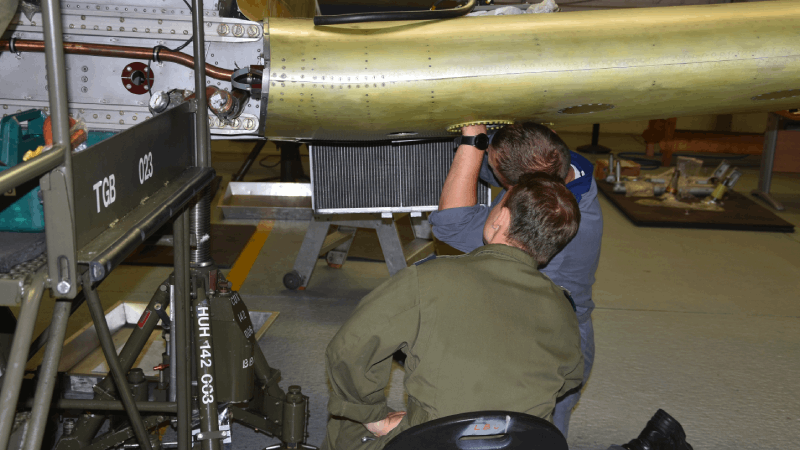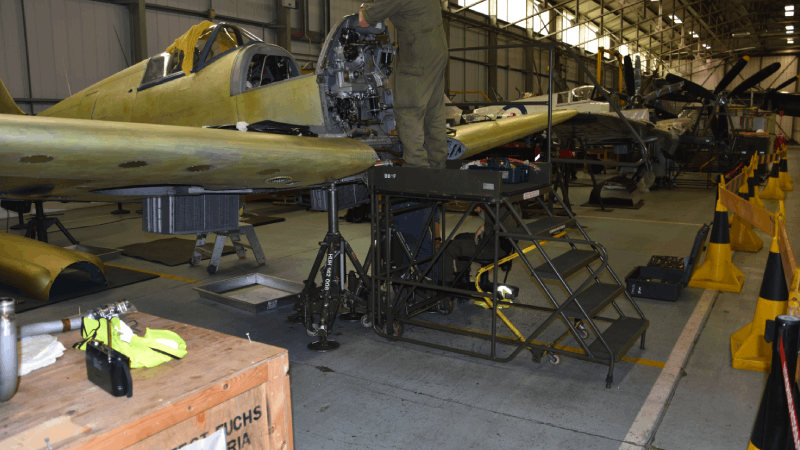Institution news
The 12th of August 2023, marks the 83rd anniversary of the beginning (in earnest) of the Battle of Britain in 1940. The Luftwaffe began to concentrate large scale attacks on RAF Fighter Command airfields in South-east England. Its aim? To destroy the RAF as a credible fighting force, in preparation for the invasion of Britain.
The Battle of Britain Memorial Flight are tasked with preserving and maintaining the airworthiness of the famous aircraft involved in the Battle of Britain. The Lancaster Bomber, the Hurricane and of course, the Spitfire. These famous aeroplanes have become synonymous with not just the Battle of Britain, but WWII itself. They can still be seen performing shows and fly-overs at events up and down the UK to this day; all thanks to these fantastic engineers. ‘We are custodians of the aircraft for a very short time. The job is to keep them going forever!’ – Sqn Ldr David Phillips.

The BBMF engineering team consists of 40 engineers, a comparatively small group for such an important task. They look after 12 aircraft, consisting of 5 different types of aeroplanes. 1 Lancaster Bomber (1 of the 2 remaining Lancasters capable of flight in the world!), 1 DC3 Douglas Dakota, 6 Spitfires, 2 Hurricanes and 2 Chipmunks (predominantly used as training aircraft).
JA – Do you feel the weight of responsibility, being the caretakers of these famous machines? For example, looking after the last remaining flyable Lancaster in Europe, along with the other aircraft we have mentioned, knowing the significance of these aeroplanes to millions of people around the globe.
DP – Well an example of this would be in June. We flew a formation of RAF aircraft for the King’s birthday fly-past, which should have been for the Coronation but this was postponed due to the weather. So, we feel the pressure is on to get the aircraft ready for flight, especially the Lancaster. People notice when the Lancaster doesn’t fly, and it’s not as if I can just pull another one out the hangar if for whatever reason it isn’t fit to fly. Everything we do is in the public eye. If anything goes wrong, there’s no hiding.
JA –I imagine there are a lot of people who have a passion for the history as well as the engineering of these machines. Lots of keen eyes watching not just your shows but trying to sneak a peek down at Coningsby.
DP – We call it spotter’s corner! On the fence line we have a viewing area, every time we open up the hangar doors there are enthusiasts there. With social media these days, there are often people who know what is going on with the aircraft before I do! (Laughs)
JA – It is amazing to see the place these aeroplanes hold in the hearts of many Brits (and others). Which leads me to my next question – How important do you think it is to continue this practice of ‘heritage engineering’, and what are the challenges that come with that?
DP – Our purpose is firstly to commemorate the past but then also to inspire the future! The reason we do these airshows is to get young people interested in these amazing machines and engineering. ‘Wow, look at that. That’s really cool. How can I get involved in engineering?’. It’s engineering that keeps these fantastic machines in the air and hopefully we inspire the next generation of engineers. There’s nothing quite like hearing 1 Merlin engine going overhead, let alone 4! In terms of challenges, my team are all volunteers and experienced engineers from throughout the RAF. This is important, as it takes a lot of experience to work on BBMF. More than this, you must also have a love for the type of engineering we do here. It is so different to everything else, which these days can be very ‘plug and play’ where the computers will tell you what requires changing. Whereas here, you have got to do first principle fault finding, you have to understand mechanically how things work as there are no computers here. It’s not something that is necessarily taught at RAF Cosford (Training School) anymore due to the advances in technology. Almost everyone in the BBMF team is a ‘petrol head’ and has a love for this kind of work.
I think the main challenges we have are keeping the skills alive and acquiring parts. We rely a lot on civilian industry for our parts. We have pretty much used up our war-time stock of components, so getting those made and approved for use can be tough. Clearly regulations have evolved with time, these parts were designed in the 1940s if not the 30s…they were built to a very different standard and trying to make them fit the new standards is quite hard. Things like the cooling radiators on our aircraft, they are all water-cooled piston engines and have massive radiators to keep them cool which often break as they’re so old. Trying to get these fixed is an artisan job! There are only so many people in the world who can make those radiators. There’s also a massive civilian warbird fleet out there trying to find the same kind of people with these rare skills. Those artisan skills of bending pipes, making radiators, making bespoke panels to fit the aircraft. It’s not just engineering, it is craft skills that we need to keep alive.
JA – A more personal question now David - What would you say is your favourite of the 12 aircraft you look after?
DP – My favourite is PZ865. It’s a Hurricane MkIIC currently painted in night fighter black. I love the Hurricanes because the Spitfires get all the praise. There were more Hurricanes in the Battle of Britain than Spitfires. They were easier to fly, easier to fix in a lot of ways because they were a known technology. They’re just rugged! And that one looks particularly mean! Hurricanes were used in so many different ways too.
